IDENTIFYING VAD UNIFORM
*****
While VAD uniform was strictly controlled by the Joint War Committee of the British Red Cross Society and Order of St. John (JWC), it is surprising how many changes took place between 1909 and the end of the Great War. There were some official changes in uniform during that time, and in addition women liked to remain individuals, and some tried to introduce little changes in what they wore, though these were usually firmly rejected by their superiors. The following images may help to clarify some of the differences and changes, but in the absence of colour photography, it's hard to avoid confusion!
*****
This photo shows a British Red Cross Society gathering at some time between 1909 and 1914. The uniform is very 'uniform', with similar red crosses on all the aprons and most of the hats - the symbol on hats became virtually absent during WW1, only appearing again during the inter-war period. The dresses are in mid-blue, which remained unchanged over the years, although the dress of the woman nearest the camera is darker, and she's possibly a trained nurse in a dress of darker blue.
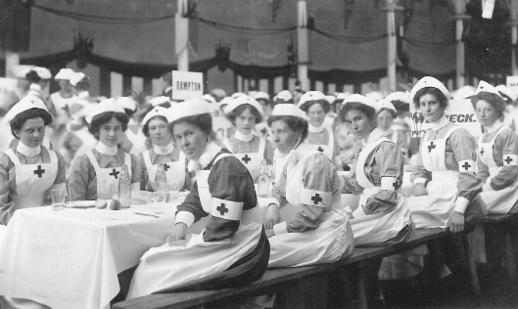
*****
This group photo was taken during the first year or so of the Great War. The very plain nurses' caps, with some variety in size and style, are typical of the early period, as changed during the summer of 1915. The woman sitting in the front row in outdoor uniform is likely to be the Commandant who had overall charge of the administration of the unit, and on her left, the nurse in a lighter dress, and different style of hat is probably a trained nurse - perhaps the only trained nurse working there.
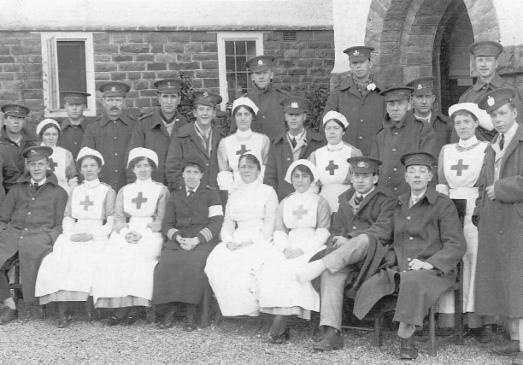
*****
*****

*****
This is another early war photo, taken at King George Hospital, Stamford Street, London - the largest military hospital in the UK contained within just one building and I have to admit that I don't fully understand the uniforms here. The young woman on our far right is clearly a BRCS VAD, with a cap similar to those shown previously and a red cross on her apron. The other women are wearing rather different pleated caps of a style not usually seen. King George Hospital was a military hospital run under the auspices of the War Office, opened in May 1915, and it carried a mixed staff of trained military nurses, civil nurses, Joint War Committee VADs, and also Special Military Probationers. SMPs worked under very similiar conditions to VADs, but were recruited by the War Office and had no connection with the British Red Cross Society. I tend to think that the woman in the front of the photo is a Special Military Probationer, with the others being either SMPs as well, or perhaps civil nurses.
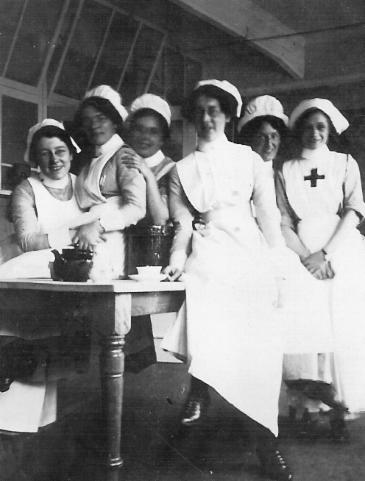

*****
By early 1915, there had developed some laxity over the style of cap worn by untrained
nursing staff, with quite a few adopting the triangular floating 'veil'
of the trained military nurse. In an effort to placate professional nurses who were already unhappy at having to work alongside the 'amateur' in wartime, the Joint War Committee introduced a new type of cap for VADs to make them easily distinguishable when in uniform. This change occurred between August and November 1915, so it is a helpful signpost when dating photos. This photo shows a VAD auxiliary hospital after that change, with the nurses wearing the handkerchief style caps tied at the nape of the neck, a style that became so strongly associated with the Great War VAD.
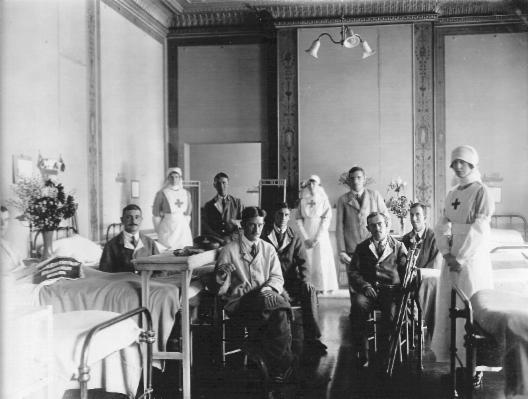
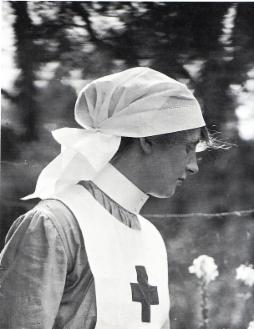
*****


*****
During the autumn of 1917, a series of 'stripes' were introduced for VADs to wear on the sleeve of their dresses, and there were different colours to signify different things. White stripes were issued to denote length of service for VADs working for the Joint War Committee, and red stripes to VADs under contract to the War Office to denote that they had been certificated as 'efficient' by their Matron and Commanding Officer. Late in the war, JWC nurses could also be awarded efficiency stripes which were blue in colour. In this photo, taken at a British Military Hospital in Calais in early 1919, two of the nurses have two red 'efficiency' stripes - a sign that they had at least two years continuous service in military hospitals, and had proved to be competent workers.
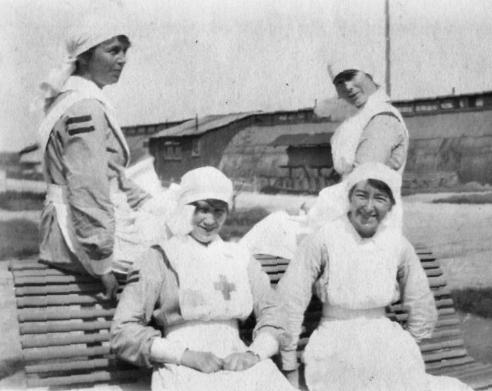
*****
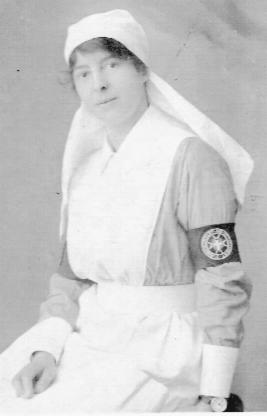
If you're trying to identify the uniform of a trained military nurse of the Great War, see this page:
IDENTIFYING UNIFORM - TRAINED MILITARY NURSES

*****
Photos taken during the later years of the war can be particularly confusing. Although in general strict regulation should have ensured that nurses' dress remained very much the same, it did lose much of the pre-war uniformity. Red crosses disappeared from many aprons. It's often suggested that the presence of a red cross on a nurse's apron was a sign, or not, of a certain seniority or greater experience, when in fact this lack was rather to do with wartime shortages of red cloth. It's also true that the Special Military Probationers, who were untrained nurses employed by the War Office, had no connection with the British Red Cross, and their uniform aprons did not bear the symbol of the organisation. In the previous image, the nurse sitting on the seat could be a Special Military Probationer, or simply a VAD without the red cross on her apron. VADs who were part of the Order of St. John wore grey dresses rather than the BRCS mid-blue, but in black and white photos this distinction is very hard to make. They did wear the St. John armband, but this is not always visible, and of course, there was no red cross on their aprons. The next image is of a group of St. John VADs later in the war, but the style of their uniform, their skirts and their collars are subtley changed to give a far more fashionable look.
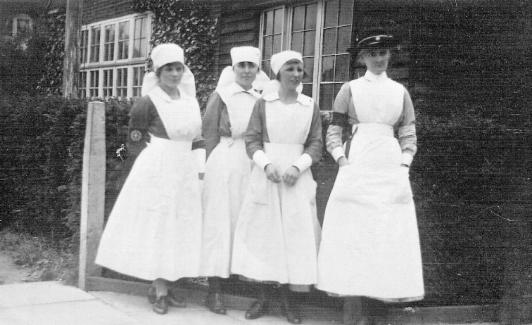
And this is a more 'regulation' photo of a typical St. John VAD, no red cross on her apron and easily identifiable by her St. John brassard:


*****
This next photo is a real mixture. A VAD stands in the centre, hat, apron and oversleeves as expected, and a second VAD, no cross on her apron, is on her right. The woman standing at the top of the steps with the dog is either the Commandant, or a trained nurse. Just below her, without an apron, is a trained nurse of the Joint War Committee with appropriate collar, hat and belt buckle, and she has her hand on the shoulder of a woman whose hat marks her out as another trained nurse. The woman on the our far left looks to be wearing a style of cap different to the usual VAD cap, and I couldn't guess at her status.
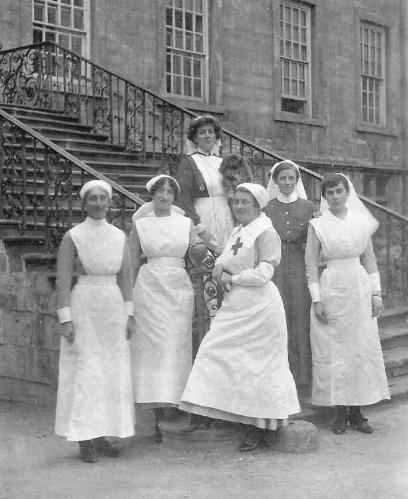
*****

*****
I know some of the background to this photo, and it's a good example of a mixed British Red Cross Society group later in the war. The woman seated at the front is the Commandant, and almost certainly wearing a dress of dark red to mark her status. In the back row, from left to right, is the senior VAD of the hospital, and two trained nurses. Those three women would all be wearing blue dresses, though those of the trained nurses a darker shade. By this stage, it does seem that the most significant marker of a trained nurse is the army-style 'veil' cap.
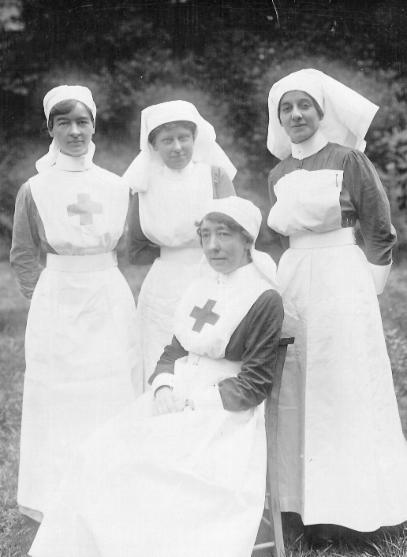

*****
And this last photo, though not of great quality, does show a group of VADs in outdoor uniform, and actually enjoying themselves in Hardelot Woods, between Boulogne and Etaples, in France. At least it proves that they occasionally got out of caps and aprons.
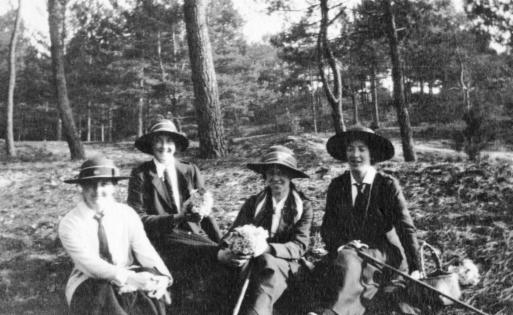

If you're trying to identify the uniform of a trained military nurse of the Great War, see this page:
IDENTIFYING UNIFORM - TRAINED MILITARY NURSES